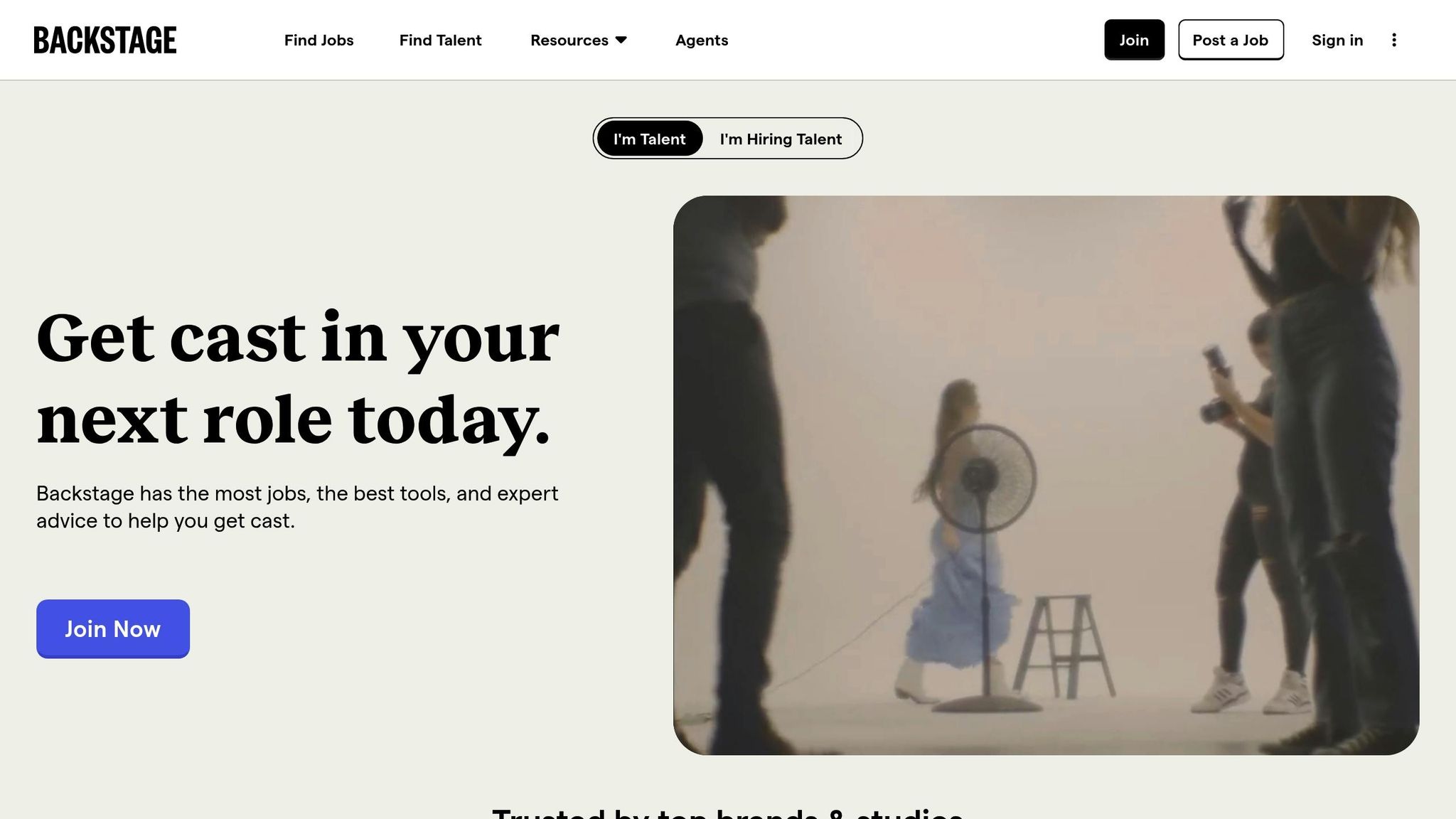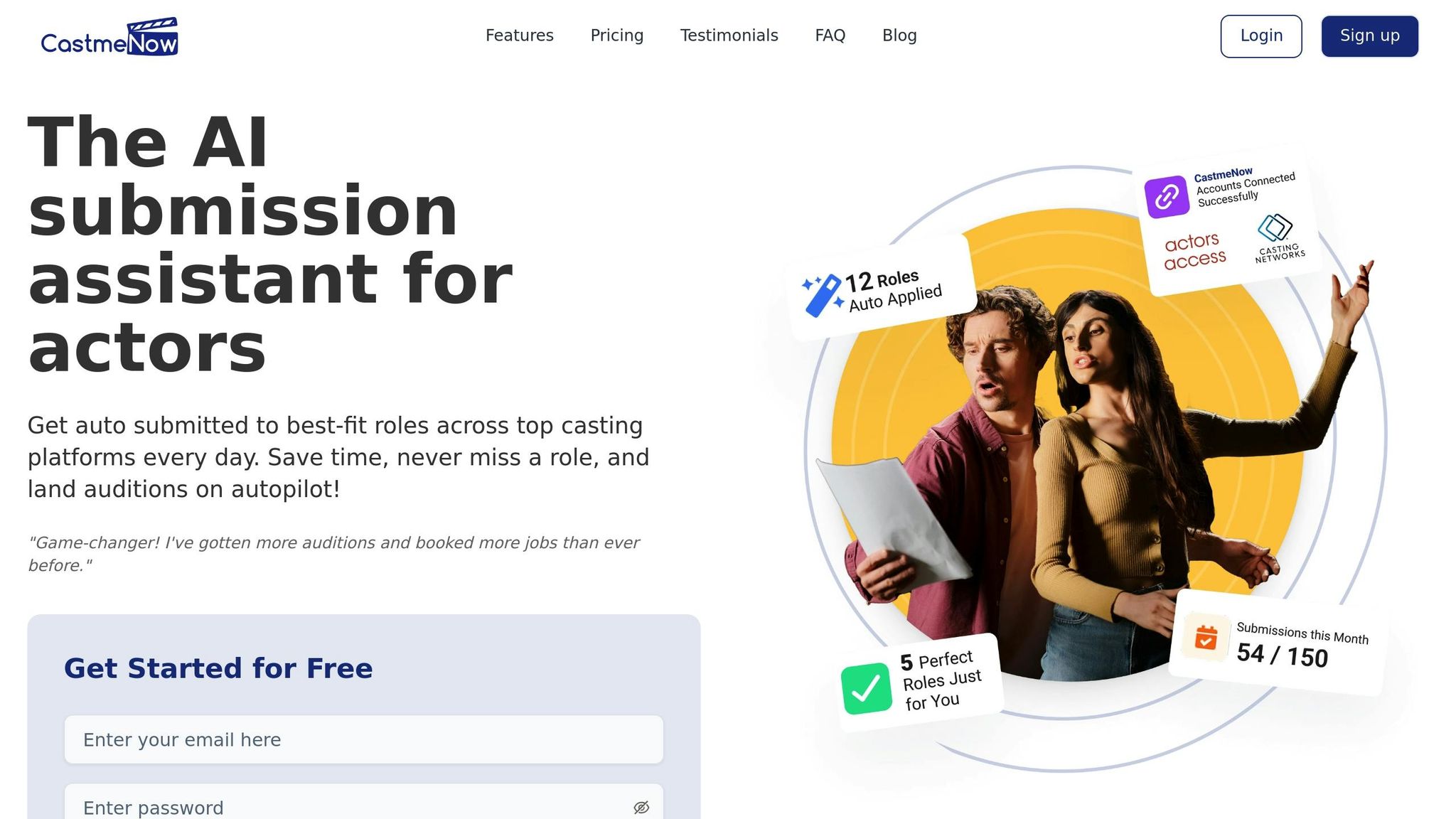Actor Market Trends: Insights from Casting Data
Explore the evolving landscape of casting with insights on self-tapes, automation, and representation trends for actors in the industry.

The casting industry has shifted dramatically in recent years, driven by technology, diversity efforts, and changing audition norms. For actors, understanding these changes is crucial to staying competitive. Here's what you need to know:
- Self-tape auditions dominate: These became standard during the pandemic and remain the primary method for casting. They save time and expand opportunities but can be costly and time-consuming for actors to produce.
- Digital platforms lead the way: Tools like Casting Networks and Actors Access have replaced traditional methods, making it easier to find and apply for roles.
- Automation is reshaping applications: Services like CastmeNow streamline submissions by automatically matching roles to actor profiles, saving time and increasing exposure.
- Diversity improves slowly: Streaming platforms and commercials are leading the charge for more inclusive casting, but progress varies across the industry.
- Gender representation evolves: Female-led and non-binary roles are increasing, but pay gaps persist.
Actors can benefit from automation tools to save time and boost opportunities. For instance, CastmeNow offers plans starting at $3/month, ensuring timely applications and providing analytics to refine strategies. A 30-day free trial makes it easy to test these tools.
To succeed in this evolving landscape, actors should focus on building strong self-tape setups, maintaining updated profiles on digital platforms, and leveraging automation to maximize opportunities.
5 Backstage Casting Experts on 2021’s Audition Trends - In The Envelope: The Actor's Podcast

Major Casting Data Trends for 2024–2025
Recent reports highlight notable changes in how actors approach auditions and submit their work. These trends shed light on shifts in audition methods, actor demographics, and the growing influence of automation in the casting process.
Rise of Self-Tapes and Virtual Auditions
Self-tapes and virtual auditions have become the go-to method for initial casting rounds. While this trend gained traction during the COVID-19 pandemic, it has now firmly established itself as the standard process. The benefits are obvious - actors save on travel, and casting directors can review submissions at their convenience. Moreover, this format opens doors for talent in smaller markets, allowing them to compete for roles without the need for relocation or expensive travel.
But it’s not all smooth sailing. For instance, one actor reported creating 50 self-tapes without landing a single role, spending up to 8 hours per tape and as much as $150 on professional services for each submission. This highlights the time and financial strain that can accompany this new norm.
Demographics of Cast Actors
Casting data reveals that directors now request over 200 self-tapes for a single role. This reflects the broader reach of digital casting but also underscores the intense competition actors face. With casting calls extending to a wider range of regions, the pool of talent has grown exponentially.
Move to Digital Submissions
The entertainment industry has fully embraced digital platforms for casting, making automated submissions the standard. While these platforms simplify the process, they’ve also led to a surge in audition materials. Actors often spend hours - or even days - perfecting their self-tapes, investing in equipment and studio time, only to receive little to no feedback.
To help alleviate these challenges, automation tools are stepping in. Platforms like CastmeNow integrate with existing profiles on Casting Networks and Actors Access, automatically matching actors with suitable roles and submitting applications continuously. This ensures actors don’t miss out on opportunities due to timing or the overwhelming volume of available roles.
Diversity and Representation in Casting
The entertainment industry has made strides in casting more inclusively, but the progress is far from consistent across all demographics and types of productions. While some areas have embraced change, others still face significant challenges. Let’s break down the trends in racial, ethnic, and gender representation and explore how they impact both the market and audiences.
Racial and Ethnic Representation Trends
Television and streaming platforms are leading the way when it comes to diverse casting, setting a higher standard compared to major studio films, which continue to lag behind. On the other hand, independent films often showcase a stronger commitment to inclusivity. Commercials have also stepped up, offering more opportunities to actors from underrepresented backgrounds. This shift is largely driven by changing consumer expectations and the accountability brought about by social media.
Gender Representation in Lead Roles
Streaming platforms are showing notable progress in gender representation, with more female-led projects and slowly increasing opportunities for non-binary actors. However, despite these advances, gender pay disparities remain a pressing issue, underscoring the ongoing need for fair and equal compensation.
Effect on Box Office and Audience Response
Diverse casts aren’t just a win for representation - they’re also good for business. Productions featuring a variety of voices and perspectives tend to draw in more engaged audiences and deliver stronger financial returns. Streaming data backs this up, showing that inclusive content drives higher viewership and sparks more social media buzz. Advertising strategies are also shifting, with budgets increasingly prioritizing authentic representation. Globally, inclusive storytelling resonates with international audiences, influencing casting decisions across the board.
For actors, understanding these trends is key to navigating today’s evolving industry. While opportunities for inclusive casting are expanding, the pace of change still varies depending on factors like production type and budget.
Technology and Automation in Casting
The casting world has seen a dramatic shift with the rise of digital tools, reshaping how actors manage their careers. Casting directors now rely heavily on digital platforms to streamline their processes, while actors are turning to automation to keep up with the fast-paced nature of casting decisions and the sheer volume of roles available.
This move toward digital-first casting has opened new doors but also introduced challenges. Platforms like Casting Networks and Actors Access post countless roles daily, making it easy for actors to feel overwhelmed. Traditional, manual applications often fall short, as roles can be filled within just hours of being posted. To address this, automation tools tailored to actors' needs have emerged, offering a way to simplify the application process and rethink career management in the casting industry.
Automation Tools for Actors
Automation tools such as CastmeNow are changing the game for actors. These tools don’t replace existing platforms like Casting Networks or Actors Access but instead work alongside them as an automation layer. They seamlessly integrate with an actor's profile, automating the discovery of roles and the application process.
Take CastmeNow, for example. This system runs continuously, ensuring actors don’t miss opportunities - even when they’re asleep, on set, or busy auditioning. It uses sophisticated algorithms to match job postings with an actor’s profile, preferences, and career goals. The result? Applications are tailored and relevant, avoiding the scattershot approach of applying to every role indiscriminately. Actors can customize parameters like age range, location, and role type to align with their ambitions.
Advantages of Automated Submissions
Automation offers speed, consistency, and precision that manual efforts simply can’t match. Submissions happen within minutes, ensuring actors stay ahead of the competition. Plus, automation tools often provide valuable data analytics to help refine targeting strategies.
One of the standout benefits is the expanded reach automation provides. By handling applications across multiple markets and platforms simultaneously, actors can tap into opportunities they might otherwise miss. This broader exposure increases their chances of landing diverse roles and building a well-rounded portfolio.
How CastmeNow Simplifies Career Management

CastmeNow takes these advantages a step further, offering tools that elevate an actor’s career strategy. Its intelligent automation operates around the clock, adapting to each actor’s unique profile through consistent feedback. On top of that, it delivers actionable insights, helping actors identify which opportunities are worth pursuing.
This data-driven approach empowers actors to make smarter decisions about where to focus their efforts. Whether it’s identifying trends in successful applications or honing in on specific markets, the analytics provided by CastmeNow can be a game-changer.
For those interested, CastmeNow offers two subscription options: the Basic Plan at $3/month, which allows for up to 10 daily applications, and the Unlimited Plan at $8/month, which includes advanced analytics. Both plans come with a 30-day free trial, giving actors full access to all features before committing.
Manual vs. Automated Application Methods
Actors today face a choice between two distinct approaches to casting applications: manual and automated. Each method comes with its own set of advantages and challenges, influencing how actors manage their workflow and pursue career opportunities. Here's a closer look at how these two methods stack up when it comes to efficiency, reach, and personalization.
Manual applications follow a more traditional path. Actors personally browse casting platforms, carefully select roles, and submit applications tailored with cover letters and headshots. While this method allows complete control over every submission, it can be time-intensive and limit the number of roles an actor can realistically apply for in a single day.
On the other hand, automated methods streamline the entire process. Tools like CastmeNow use an actor's profile to automatically discover and apply for roles across multiple platforms. This approach not only saves time but also ensures timely submissions and broader outreach, allowing actors to focus on other aspects of their craft.
Comparison Table: Manual vs. Automated Applications
| Factor | Manual Applications | Automated Applications |
|---|---|---|
| Time Investment | Requires significant daily effort | Minimal effort after an easy initial setup |
| Application Speed | Relies on individual review and tailoring | Quick, streamlined submissions |
| Coverage | Limited by available hours | Broad reach across multiple platforms |
| Consistency | Dependent on personal schedule and energy | Continuous, steady flow of applications |
| Personalization | Highly customizable for each role | Matches roles based on profile details |
| Cost | Costs valuable personal time | Modest subscription fee ($3/month Basic; $8/month Unlimited) |
| Market Reach | Typically focused on one platform at a time | Expands outreach to several platforms |
As the casting process becomes increasingly digital, automation is proving to be a powerful tool for actors. It even offers analytics to help fine-tune application strategies.
Switching to Automated Methods
With the clear benefits of automation, many actors are embracing this approach for its consistent and expansive outreach. To get started, actors need to update their profiles on platforms like Casting Networks and Actors Access. Once linked to a service like CastmeNow, the system takes over, automatically matching roles to their profiles and submitting applications.
For those who want to retain a personal touch, combining both methods is a practical option. Actors can still manually apply to high-priority roles while relying on automation for broader coverage. CastmeNow offers flexible subscription plans to suit different needs. The Basic Plan costs just $3 per month and is ideal for trying out automation with a limited daily quota. For those seeking maximum exposure and advanced analytics, the Unlimited Plan at $8 per month offers continuous applications. Both plans include a 30-day free trial, giving actors the chance to experience the benefits of automation risk-free.
Key Takeaways and Next Steps
The casting world is evolving rapidly, with digital transformation at its core. Self-tape auditions, expanded opportunities, and streamlined application processes are reshaping the industry. Actors who embrace these changes are setting themselves up for better career prospects.
Go digital to stay ahead. A solid self-tape setup is essential, along with regularly updated profiles on platforms like Casting Networks and Actors Access. These are now non-negotiables for staying competitive.
Let automation work for you. Casting directors sift through hundreds of applications daily, so timing and consistency are critical. Relying solely on manual submissions can mean missing out on time-sensitive roles. Tools like CastmeNow automate the process, ensuring your applications are submitted 24/7 to relevant roles. This not only broadens your reach but also allows you to focus on honing your craft.
Pick the right plan for your needs. If you're just starting or have lighter requirements, the Basic Plan ($3/month) allows up to 10 applications daily. For those looking to go all-in, the Unlimited Plan ($8/month) offers continuous applications and advanced analytics to track results.
Take advantage of the 30-day free trial to see how automation can impact your application rate and callback success. It's a risk-free way to explore how these tools can elevate your career.
Once you’ve automated your submissions, keep an eye on your analytics. Use the data to understand which roles generate the most interest and tweak your profile to align with those trends. This adaptive approach can significantly improve your chances of success.
The casting landscape is constantly shifting, but by combining these actionable strategies with automation, you can enhance your visibility and focus on your artistic growth. Let technology handle the logistics while you concentrate on what you do best.
FAQs
What are some practical ways actors can save time and money when creating self-tape auditions?
Actors can cut down on both time and expenses for self-tape auditions by creating a dedicated home recording space equipped with budget-friendly, high-quality gear. A consistent and well-lit setup means you won’t have to constantly tweak your environment or rely on pricey studio rentals.
To make the process even smoother, consider batching multiple auditions in one recording session. This approach minimizes setup time and helps you get more done in less time. Tools like CastmeNow can also be a game-changer, automating role applications so you can devote more energy to refining your performances. It’s a practical way to simplify the audition process while keeping costs in check.
How can actors make their profiles stand out on casting platforms like Casting Networks and Actors Access?
To make your profile stand out, it's important to keep it complete and current. Fill out all searchable fields, including details like ethnicity, physical traits, and any special skills. This makes it easier for casting directors to find you.
Make a habit of updating your profile with your latest credits, training, and high-quality headshots. Including a concise, engaging bio or personal backstory can add a touch of personality, making your profile more memorable. Highlight what sets you apart as a performer to grab attention and leave a strong impression.
How does automation improve the casting application process compared to traditional methods?
Automation simplifies the casting application process by cutting down on time and ensuring applications are customized for specific roles. This approach not only opens up a broader range of opportunities for actors but also aligns those opportunities with their preferences, boosting the likelihood of landing roles that truly fit.
Compared to traditional methods, automation minimizes manual work, improves precision, and enhances overall efficiency. By taking care of repetitive tasks and offering real-time updates, it frees up actors to concentrate on refining their skills while staying competitive in the ever-changing casting landscape.

